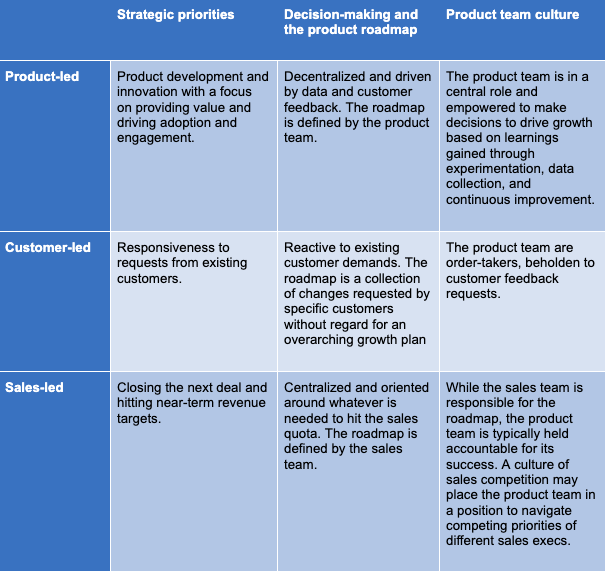What is a company if not a vehicle for delivering products that meet customer needs? Whether that product is a software application, a physical doo-dad of some kind, or a service like consulting or transportation, or warehousing, every company provides some value to customers in exchange for compensation. That value is the company’s product. The organization wouldn’t exist without it. In a nutshell, a product-led organization is a business that makes its products the vehicle for acquiring and retaining customers, driving growth, and influencing organizational priorities.
Product-led vs. product-centric organizations
Before diving into this definition further, it’s important to distinguish between product-led and product-centric organizations. Product-led organizations focus on building and delivering products that deliver value. They view product development and customer experience as the primary drivers of growth. In contrast, product-centric organizations focus on product innovation for its own sake without necessarily considering customer needs. They fall in love with what they are building rather than seeking to deliver value. Lastly, they become disconnected from the market they are serving. The best product-led organizations are, in fact, customer-centric, not product-centric.
Another helpful distinction is the difference between a product-led organization and product-led growth. A product-led organization is one whose product team plays a central role in strategy and decision-making. Product-led growth involves a specific strategy in which access to the product is the primary sales tactic. Free trial periods and freemium models allow access to the product either for a limited time or with a limited set of features with the belief that the product will essentially sell itself. Depending on the product, a product-led growth strategy may or may not be appropriate.
A comparison of alternatives
To better understand the concept of a product-led organization, it’s helpful to look at the differences between product-led, customer-led, and sales-led organizations. First, some quick definitions:
- A customer-led organization is one in which input from existing customers becomes the primary driving force for strategy and decision-making, regardless of whether that input will lead the company in a direction that is profitable over the long term. Differences exist between a customer-led organization and a customer-centric one. A customer-centric company focuses on customer experience and delivering value within the context of a broader strategy; a customer-led company lets customers define the strategy.
- A sales-led organization focuses on closing deals and generating revenue such that the sales team becomes the primary owner of strategy and decision-making.
Let’s look at some other points of comparison between these concepts, specifically in how the different approaches impact the product team:

For many companies, becoming a product-led organization requires a significant transformation in several areas. In a series of articles in 2022, Marty Cagan and Jon Moore summarized the three areas of transformation to becoming product-led as follows:
- A change in how products are built and deployed. Moreover, in software, this transformation involves moving from big, infrequent releases to a more frequent cadence of small changes.
- A change in how problems are solved. This transformation involves moving from customer- or stakeholder-driven roadmaps to those defined by product teams empowered to discover customer needs and come up with solutions that are viable, valuable, feasible, and desirable.
- A change in how companies decide which problems to solve. Consequently, companies must learn to prioritize work around a well-defined product vision, growth, and investment strategy grounded in data and customer-centricity.
To make such a transformation, organizations must recognize that these changes are both profound and difficult. The existing product leadership and team may or may not have the correct skill set. Transforming from a customer-led organization to a product-led organization also represents a shift in power.
Becoming a product-led organization is no guarantee of success. It depends on multiple factors, including, for example, product-market fit, leadership, and competitive landscape. Lastly, every organization has to select which approach is right for them based on their strengths, values, and goals.